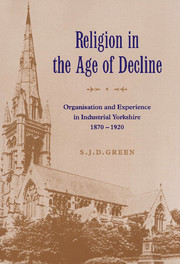Book contents
- Frontmatter
- Contents
- Acknowledgements
- List of tables
- List of abbreviations
- Introduction
- Part I Providing the means
- Part II Drawing in the people
- Part III The trials of the religious life
- 7 Worship exalted and experience eclipsed: liturgical orderliness, dutiful observance and the making of a modern Christian witness
- 8 Christianity within and beyond the churches: the pattern of the devotion and the authenticity of expression
- 9 The forward march of the Christian churches halted? Organisational stasis and the crisis of the associational ideal in early twentieth-century religious institutions
- Conclusion
- Bibliography
- Index
8 - Christianity within and beyond the churches: the pattern of the devotion and the authenticity of expression
from Part III - The trials of the religious life
Published online by Cambridge University Press: 08 October 2009
- Frontmatter
- Contents
- Acknowledgements
- List of tables
- List of abbreviations
- Introduction
- Part I Providing the means
- Part II Drawing in the people
- Part III The trials of the religious life
- 7 Worship exalted and experience eclipsed: liturgical orderliness, dutiful observance and the making of a modern Christian witness
- 8 Christianity within and beyond the churches: the pattern of the devotion and the authenticity of expression
- 9 The forward march of the Christian churches halted? Organisational stasis and the crisis of the associational ideal in early twentieth-century religious institutions
- Conclusion
- Bibliography
- Index
Summary
Introduction: from ordered witness to common practice
A public religious sensibility which was now more self-consciously ‘devotional’ than ‘experiential’ was not necessarily any less intense. But it was, so to speak, more obviously regulated. Put another way, it observed the chronological divisions of life more closely: the week, the year, the seasons, and even of the generations. To be sure, this moral concentration upon the sacred dimensions of chronological order was rather more a matter of shifting than of wholly altering characteristic ecclesiastical and communal emphases. This was true, if for no other reason, because sacred division of life was scarcely new to the later nineteenth century. Nor was its more profound cultivation in Victorian West Yorkshire entirely planned. But, just as the contemporary beautification of religious space had, seemingly by a super-denominational logic of its own, surreptitiously intruded an enhanced sacralisation of particular religious events into a converging devotional life, so the elaboration of religious worship, again apparently almost with a momentum of its own, gradually created a more settled order of religious observance in a common spiritual experience. This, increasingly, made religious worship not only the characteristic form of local religious life, but actually gave new, that is, newly characteristic, forms to that life, forging an appropriate type of worship for each part of an ever more appreciably consecutive individual and collective religious existence. And that change had significant consequences: for the churches, and beyond them too. They began in the increasing formalisation of the religious week.
- Type
- Chapter
- Information
- Religion in the Age of DeclineOrganisation and Experience in Industrial Yorkshire, 1870–1920, pp. 325 - 350Publisher: Cambridge University PressPrint publication year: 1996



